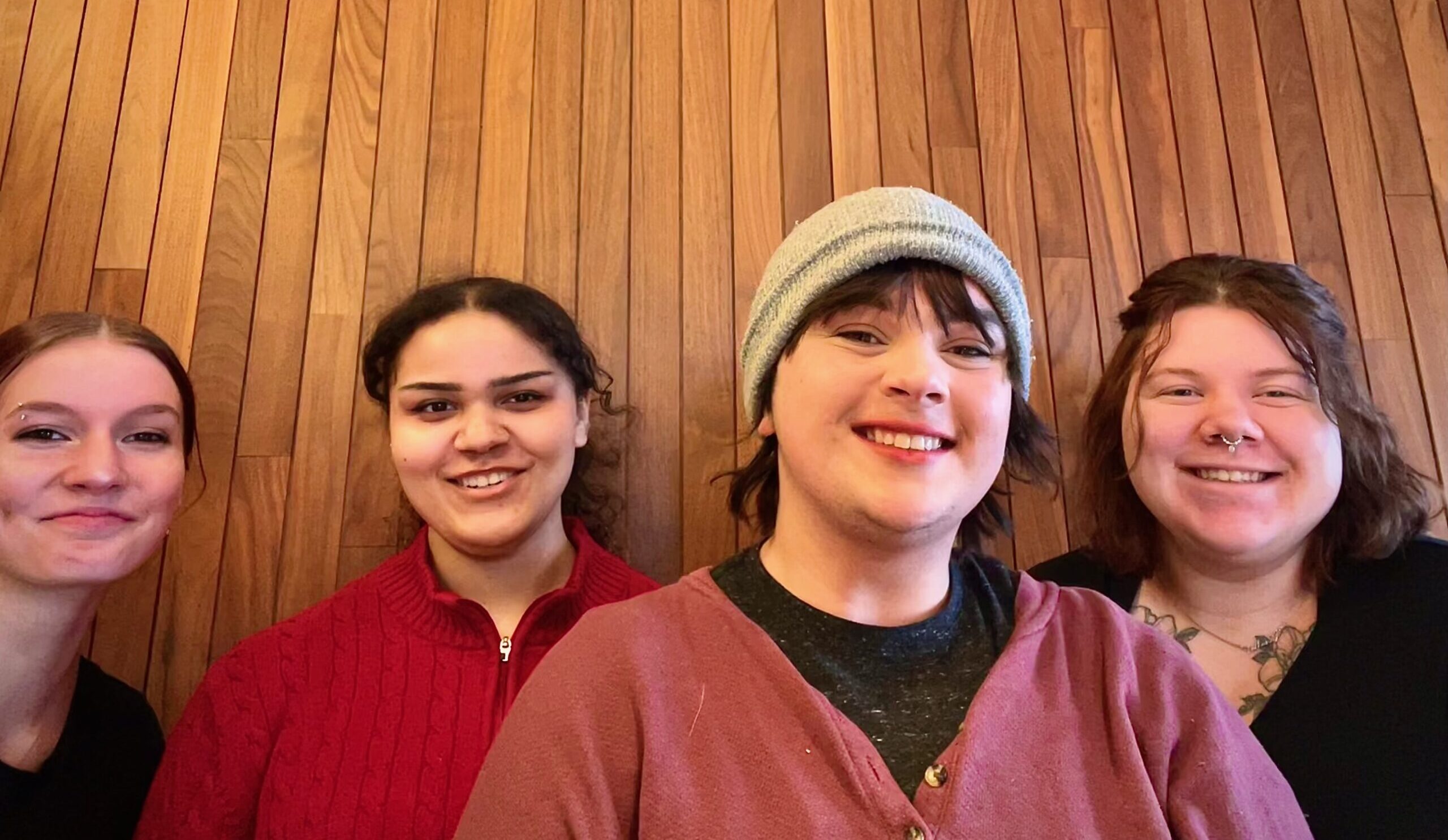
Workers from the recently unionized St. Cloud, Minn., Starbucks location pose for a photo: (Left to right) Maya Figallo, McKaylie Cobb, Courtney Fahland, Autumn Anderson.

Share
Courtney Fahland, 27, has been following the Starbucks unionization movement ever since workers’ first victory in Buffalo, N.Y., in 2021. Growing up with a mother in the teachers’ union and father working for UPS, they deeply understood the importance of a union for working people. That’s why, within two months of working at a Starbucks in St. Cloud, Minn., Fahland led the effort to organize a union.
On January 31, Starbucks Workers United announced union drives at two locations: the one Fahland works at in St. Cloud on 2nd Street S and 6th Avenue, and in Roseville, Minn., on Highway 36 and Fairview Avenue. According to a statement from Starbucks Workers United, the two shops, if they win their elections, will be joining 11,000 unionized baristas at over 530 Starbucks stores across the country.
Fahland previously worked at a Starbucks in a Target store for a few years before working at the Starbucks in St. Cloud. They listened to their coworkers’ concerns and noticed excitement for the recent strikes that took place over Christmas Eve at Starbucks stores across the country and locally. “I didn’t mean to do it so quickly,” they say of the union drive. “I was probably gonna do it in, like, six months from now, but I wanted to strike while the iron was hot.”
The 2024 Christmas Eve strike was the largest strike in Starbucks history, with over 300 stores shut down across the country to demand improved wages, benefits, and staffing levels, and to protest hundreds of unresolved unfair labor practice (ULP) charges. (Union workers are in bargaining with the company but have not yet won a contract.) According to a press release sent by Starbucks Workers United on January 31, the ULP charges keep coming: The union has filed over 90 unfair labor practice charges against the company in recent weeks “after the company backtracked on the path forward it agreed to over the future of organizing and collective bargaining.”
Fahland says that, initially, the conversations with coworkers were ironic, or “kind of joking, kind of not joking.” They remember workers asking each other, “What if we unionized and we went on strike? Wouldn’t that be funny?” That’s when Fahland emailed Starbucks Workers United while on their break to learn more about the process of forming a union.
Although Fahland was hoping to stay anonymous and take a backseat, the Starbucks Workers United organizer responded to Fahland, encouraging them to be a leader, saying, as Fahland paraphrased, “You’ve got to be brave and you’ve got to talk to people. You can’t start a union by yourself.” Fahland acquiesced—“I was like, ‘Dang it, fine, whatever.’ ”
Fahland then approached the coworker they felt would likely be supportive, or at least not tell management. The coworker responded enthusiastically, saying, “Let’s go, I already have a list of names.” Within two weeks, the St. Cloud store already had enough signed cards for a majority, according to Fahland.
“It was like whiplash,” Fahland describes the experience of unionizing over two weeks. “This is just like a dream I had and now it’s actually happening. It’s surreal.”
McKaylie Cobb, 18, also a barista at the St. Cloud Starbucks store, had little experience with unions before a few months ago. After more than two years on the job, Cobb was fed up with concerns over scheduling, pay, and favoritism. Exhausting all other options, Cobb explains, “We talked with our managers about the issues, and we felt like nothing was getting done about it, so we took it upon ourselves.”
In terms of scheduling, Cobb explains that workers often have to work both a closing and opening shift. She adds that many coworkers with seniority still struggle to secure sufficient hours and still struggle to cover the cost of living even when they do work enough hours.
Following publication of this article, a Starbucks spokesperson, Phil Gee, sent a statement calling the January ULP filings “baseless” and asserting, “We respect our partners right to choose, through a fair and democratic process, to be represented by a union or not to be represented by a union, and will continue to work together to make Starbucks the best job in retail.” Yet the company has been widely criticized, including by members of Congress, for refusing to negotiate in good faith with the union and embracing anti-union policies.
Dijah Abushagor, a barista at the Roseville Starbucks said in a press release from Starbucks Workers United, “Our store has become a high-stress environment due to excessive pressure on drive times and the lack of respect or recognition for partners’ hard work. Unionizing would give us the collective power to demand fair treatment, a healthier work environment, and the respect we deserve.”
Fahland explains that the company’s inequity made the workers’ concerns sting that much more. “It’s not great when there’s a new CEO and he makes a million times more than you ever will in your entire life. And you kind of realized that you’re the product, you’re the reason he’s making that much money.”
According to Cobb and Fahland, the union vote at the St. Cloud Starbucks store should take place within the next month. If the workers vote for a union at both the St. Cloud location and the Roseville location, there would be twelve unionized Starbucks stores in Minnesota.
When asked what it means to be organizing new unions during a time when the National Labor Relations Board is under attack by the Trump administration, Fahland says, “Right now, with young people seeing the state of the world, we see that we’re getting the short end of the stick. We’re all realizing we can’t expect anyone to show up for us, except for ourselves. So I think in a tumultuous time, it feels like I don’t really have anything else to lose.”

